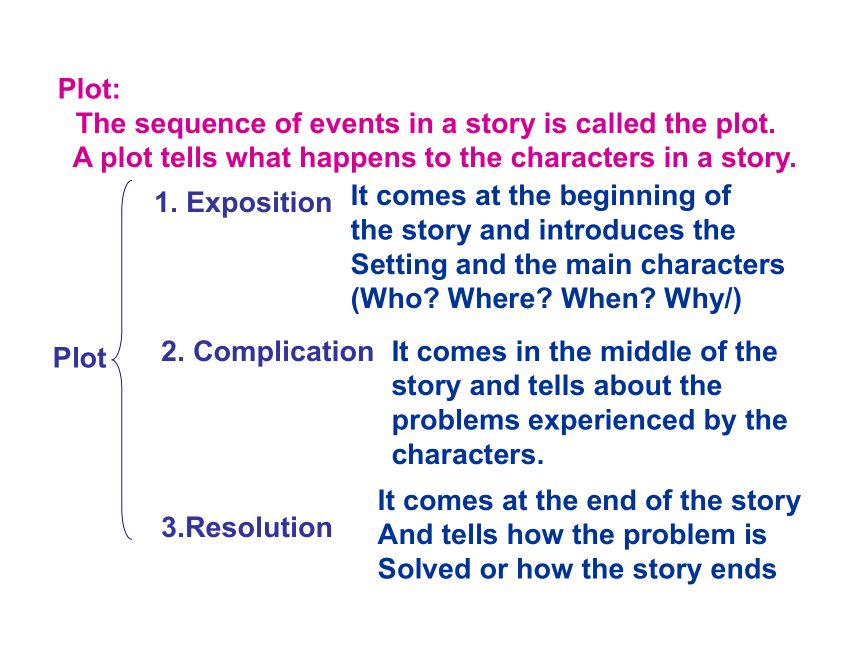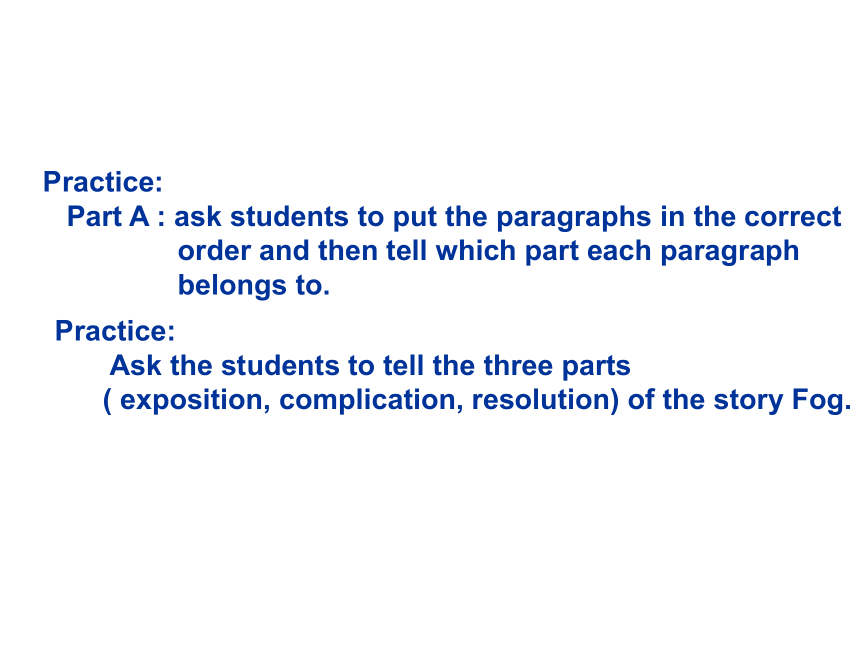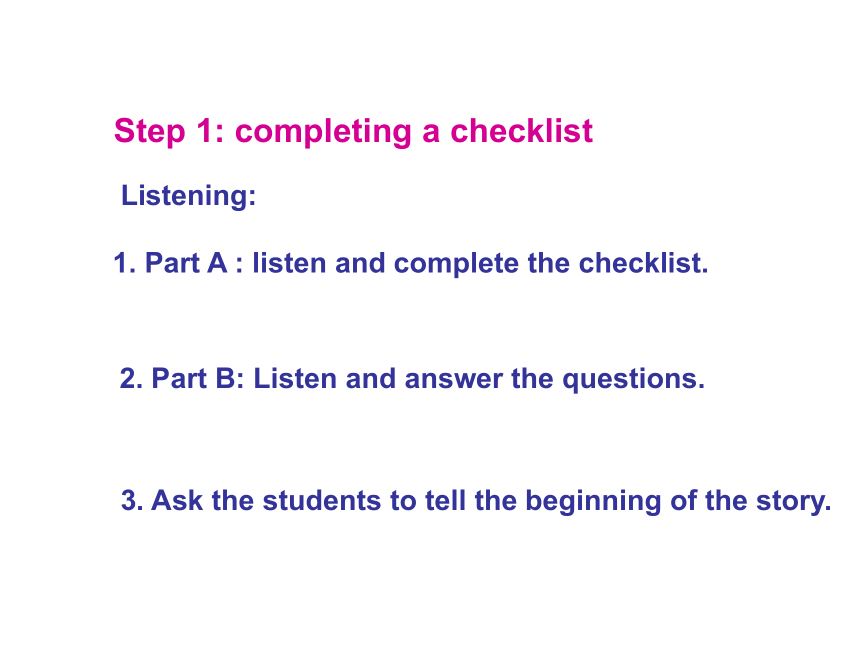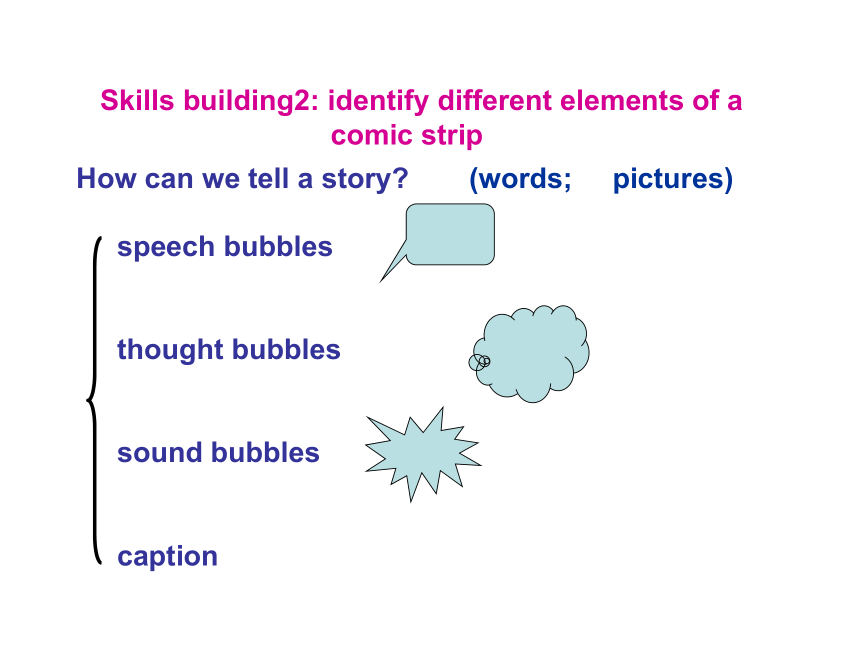unit 1 the world of our senses task
文档属性
| 名称 | unit 1 the world of our senses task |

|
|
| 格式 | rar | ||
| 文件大小 | 48.8KB | ||
| 资源类型 | 教案 | ||
| 版本资源 | 牛津译林版 | ||
| 科目 | 英语 | ||
| 更新时间 | 2011-01-14 20:53:00 | ||
图片预览







文档简介
课件18张PPT。Unit 1
The world of our senses
Task Telling a story1. Ask the students to retell the story Fog2. What kind of story do you like?science fiction
love story
detective story
historical story
plotSkills building1: plotting a storyPlot:
The sequence of events in a story is called the plot.
A plot tells what happens to the characters in a story.
Plot 1. Exposition2. Complication3.ResolutionIt comes at the beginning of
the story and introduces the
Setting and the main characters
(Who? Where? When? Why/)It comes in the middle of the
story and tells about the
problems experienced by the
characters.It comes at the end of the story
And tells how the problem is
Solved or how the story endsPractice:
Part A : ask students to put the paragraphs in the correct
order and then tell which part each paragraph
belongs to.Practice:
Ask the students to tell the three parts
( exposition, complication, resolution) of the story Fog.Step 1: completing a checklist Listening:1. Part A : listen and complete the checklist.2. Part B: Listen and answer the questions.
3. Ask the students to tell the beginning of the story.Possible example:
It happened in this summer. One morning at about 10, Sandy and her classmates went to the museum together with their teachers , because they had a class project about art and history. They got there by school bus. When they arrived at the museum, Sandy and her partner Li Feifei were so busy looking around that they got lost. So they ran about, trying to find their classmates . Luckily they saw their classmates and caught up with them. Skills building2: identify different elements of a
comic stripHow can we tell a story?(words; pictures)speech bubbles
thought bubbles
sound bubbles
caption
Practice:
1. Ask the students to tell the story 2. Ask the students to finish the comic strip
about a monster.a. Label the different ways of adding words to pictures.
b. Tell the story Homework:
1. Prepare a short story with a clear plot.2. Add four kinds of bubbles to the comic strip
and tell the story. Step2: prepare a story with a surprise ending.
1. Check the homework.2. Different stories have different endings. happy
sad
surprise
moving
thought-provoking3. Ask the students to do part A and B on page 15.Practice: Add a surprising ending to the story. That cold January night, I was growing sick of my life in
San Francisco. There I was walking home at one in the morning after a tiring practice at the theater. With opening night only a week away, I was still learning my lines. I was having trouble dealing with my part-time job at the bank and my acting at night at the same time. As I walked, I thought seriously about giving up both acting and San Francisco. I had expected too much of my life.
As I walked down the empty streets under tall buildings, I felt very small and cold. I began running both to keep warm and to keep away from any possible robbers. Very few people were still out except a few sad-looking homeless people under blankets.
About a block from my apartment , I heard a sound behind me. I turned quickly, half expecting to see someonewith a knife or a gun. The street was empty. All I saw was a shining streetlight. Still, the noise had made me nervous, so I started to run faster. Not until I reached my apartment building and unlocked the door did I realize what the noise had been. It had been my wallet falling to the sidewalk.
Suddenly I wasn’t cold or tired any more. I ran out of the door and back to where I’d heard the noise. Although I searched the sidewalk anxiously for 15 minutes, my wallet was nowhere to be found. ……Skills building3: using adjectives and adverbs in stories1.What kinds of words are the words in red and blue?2. What is the fun_ction of them?(make the story more interesting and lively)adjectives:
2. to express physical and other qualities, our feelings
and views
3. to express origin, necessity, frequency
and degree of certainty
1. to describe a person or thing.Adverbs: 1. to add more information to a verb, an adjective,
a phrase or another adverb.
Practice: Do the exercise on page16.
2. to express place, time, frequency, degree, manner
and viewpoints.
3. to make comments, concentrate on a certain word
or phrase and link clauses or sentences.
Step3: improve your story1. Ask students to do part A.2. Part B: ask students to present their stories.
◆ tone of voice
◆ loudness
◆ rhythm of speech
◆ the expression on your face
◆ body language
◆ eye contact
◆ hand movements
◆ stress Possible example:All of a sudden, a bell ringing, Sandy woke up and found
Herself sitting on a chair. She could see people were
leaving. To her great surprise, she saw a big , red apple in her left hand and some beautiful flowers in her right hand. She knew it was time for the museum to close and she had to leave. But her classmates and her teachers were nowhere in sight. Homework:1. Do part B on page912. Prepare a story with a surprising ending3. Preview project.Thanks
The world of our senses
Task Telling a story1. Ask the students to retell the story Fog2. What kind of story do you like?science fiction
love story
detective story
historical story
plotSkills building1: plotting a storyPlot:
The sequence of events in a story is called the plot.
A plot tells what happens to the characters in a story.
Plot 1. Exposition2. Complication3.ResolutionIt comes at the beginning of
the story and introduces the
Setting and the main characters
(Who? Where? When? Why/)It comes in the middle of the
story and tells about the
problems experienced by the
characters.It comes at the end of the story
And tells how the problem is
Solved or how the story endsPractice:
Part A : ask students to put the paragraphs in the correct
order and then tell which part each paragraph
belongs to.Practice:
Ask the students to tell the three parts
( exposition, complication, resolution) of the story Fog.Step 1: completing a checklist Listening:1. Part A : listen and complete the checklist.2. Part B: Listen and answer the questions.
3. Ask the students to tell the beginning of the story.Possible example:
It happened in this summer. One morning at about 10, Sandy and her classmates went to the museum together with their teachers , because they had a class project about art and history. They got there by school bus. When they arrived at the museum, Sandy and her partner Li Feifei were so busy looking around that they got lost. So they ran about, trying to find their classmates . Luckily they saw their classmates and caught up with them. Skills building2: identify different elements of a
comic stripHow can we tell a story?(words; pictures)speech bubbles
thought bubbles
sound bubbles
caption
Practice:
1. Ask the students to tell the story 2. Ask the students to finish the comic strip
about a monster.a. Label the different ways of adding words to pictures.
b. Tell the story Homework:
1. Prepare a short story with a clear plot.2. Add four kinds of bubbles to the comic strip
and tell the story. Step2: prepare a story with a surprise ending.
1. Check the homework.2. Different stories have different endings. happy
sad
surprise
moving
thought-provoking3. Ask the students to do part A and B on page 15.Practice: Add a surprising ending to the story. That cold January night, I was growing sick of my life in
San Francisco. There I was walking home at one in the morning after a tiring practice at the theater. With opening night only a week away, I was still learning my lines. I was having trouble dealing with my part-time job at the bank and my acting at night at the same time. As I walked, I thought seriously about giving up both acting and San Francisco. I had expected too much of my life.
As I walked down the empty streets under tall buildings, I felt very small and cold. I began running both to keep warm and to keep away from any possible robbers. Very few people were still out except a few sad-looking homeless people under blankets.
About a block from my apartment , I heard a sound behind me. I turned quickly, half expecting to see someonewith a knife or a gun. The street was empty. All I saw was a shining streetlight. Still, the noise had made me nervous, so I started to run faster. Not until I reached my apartment building and unlocked the door did I realize what the noise had been. It had been my wallet falling to the sidewalk.
Suddenly I wasn’t cold or tired any more. I ran out of the door and back to where I’d heard the noise. Although I searched the sidewalk anxiously for 15 minutes, my wallet was nowhere to be found. ……Skills building3: using adjectives and adverbs in stories1.What kinds of words are the words in red and blue?2. What is the fun_ction of them?(make the story more interesting and lively)adjectives:
2. to express physical and other qualities, our feelings
and views
3. to express origin, necessity, frequency
and degree of certainty
1. to describe a person or thing.Adverbs: 1. to add more information to a verb, an adjective,
a phrase or another adverb.
Practice: Do the exercise on page16.
2. to express place, time, frequency, degree, manner
and viewpoints.
3. to make comments, concentrate on a certain word
or phrase and link clauses or sentences.
Step3: improve your story1. Ask students to do part A.2. Part B: ask students to present their stories.
◆ tone of voice
◆ loudness
◆ rhythm of speech
◆ the expression on your face
◆ body language
◆ eye contact
◆ hand movements
◆ stress Possible example:All of a sudden, a bell ringing, Sandy woke up and found
Herself sitting on a chair. She could see people were
leaving. To her great surprise, she saw a big , red apple in her left hand and some beautiful flowers in her right hand. She knew it was time for the museum to close and she had to leave. But her classmates and her teachers were nowhere in sight. Homework:1. Do part B on page912. Prepare a story with a surprising ending3. Preview project.Thanks
